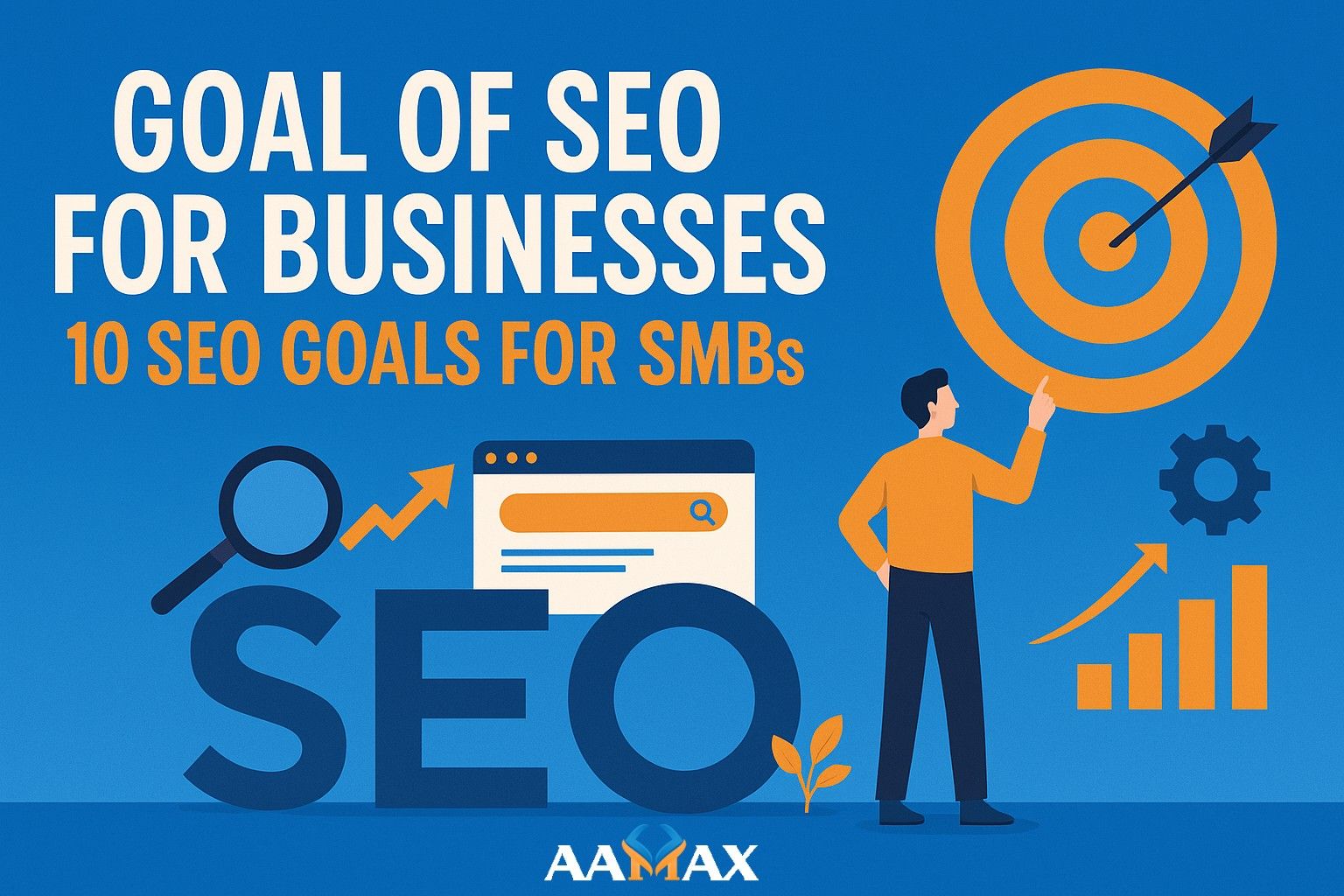
Goal of SEO for Businesses – 10 SEO Goals for SMBs
In today’s digital landscape, search engine optimization isn’t just a buzzword; it’s a foundational strategy for businesses that want to be visible, trusted, and competitive online. For small and medium-sized businesses (SMBs), SEO can be the difference between being discovered by ideal customers and being invisible in a crowded marketplace.
But what exactly should the goal of SEO be for businesses? Is it just about getting to the first page of Google, or does it run deeper? In this article, we’ll break down 10 clear, practical SEO goals that every SMB should consider to drive growth, build credibility, and ultimately increase revenue.
Why Define SEO Goals?
Before diving into the goals, it’s important to understand why defining them matters:
-
SEO isn’t a one-time project; it’s an ongoing process.
-
Without clear goals, it’s difficult to measure success.
-
Defined goals help align SEO strategy with broader business objectives.
-
They guide investment decisions and help you prioritize time and resources.
With this in mind, let’s explore 10 SEO goals designed specifically for small and medium-sized businesses.
1. Increase Organic Traffic
One of the most common goals of SEO is to increase organic traffic—the number of visitors who find your website through unpaid search results.
For SMBs, this is particularly powerful because organic traffic often has a higher intent to convert compared to paid traffic. For instance, someone searching “local bakery near me” is likely ready to buy rather than just browsing.
Key tactics:
-
Optimize your website content with relevant keywords.
-
Build quality backlinks from authoritative sites.
-
Ensure your site is technically sound and mobile-friendly.
By consistently tracking your organic traffic through tools like Google Analytics, you can monitor growth over time and refine your strategy.
2. Improve Search Engine Rankings
Higher rankings mean greater visibility. Being on the first page of search results, especially for keywords relevant to your products or services, can dramatically boost your brand’s exposure.
Why this matters:
-
Users rarely scroll past the first page.
-
Higher rankings build trust; people assume top results are the most credible.
-
Better rankings increase the chance of earning clicks.
For SMBs, the goal isn’t always to rank for the most competitive national keywords. Often, focusing on long-tail or local keywords delivers faster and more qualified results.
3. Enhance Local Visibility
For brick-and-mortar businesses or those serving specific geographic areas, improving local SEO should be a top priority.
Examples of local SEO goals:
-
Appear in the Google Local Pack (the map and top 3 listings shown for local searches).
-
Optimize your Google Business Profile to show updated contact info, hours, and photos.
-
Collect positive customer reviews to increase trust.
Local visibility helps SMBs compete effectively against larger national brands by focusing on the immediate communities they serve.
4. Increase Website Conversions
SEO isn’t just about attracting more visitors; it’s about attracting the right visitors who are likely to take action—such as filling out a form, making a purchase, or calling your business.
How to boost conversions through SEO:
-
Use clear calls-to-action (CTAs) on key pages.
-
Optimize landing pages to match searcher intent.
-
Create content that answers common customer questions.
A practical goal might be: “Increase contact form submissions from organic traffic by 20% over six months.”
5. Build Brand Authority and Trust
Appearing in search results for relevant queries helps position your brand as an authority in your industry. For SMBs, this can level the playing field against larger competitors.
Tactics to achieve this:
-
Publish high-quality blog posts, guides, and FAQs.
-
Secure backlinks from reputable websites.
-
Create educational videos or infographics.
Over time, a trusted brand attracts not just more traffic but also better partnerships and referral opportunities.
6. Reduce Dependence on Paid Ads
Many businesses rely heavily on pay-per-click (PPC) advertising to drive traffic. While PPC has its place, over-reliance can be costly, especially if click costs rise.
Why organic SEO helps:
-
It delivers ongoing traffic without per-click fees.
-
A balanced mix of paid and organic traffic is more sustainable.
-
SEO creates assets (content, backlinks, technical improvements) that benefit your business long-term.
Setting a goal like “Increase organic traffic to account for 50% of total site visits” can help reduce marketing costs and dependency on ads.
7. Support Other Marketing Channels
SEO doesn’t work in isolation—it complements your other digital marketing efforts:
-
Content created for SEO can be shared on social media.
-
SEO insights can guide topics for email newsletters.
-
Optimized landing pages can improve conversion rates for PPC campaigns.
By integrating SEO goals into your broader marketing strategy, you create a cohesive brand presence that resonates across multiple platforms.
8. Optimize for Mobile Users
More than half of global web traffic now comes from mobile devices. For SMBs, ensuring a fast, responsive mobile experience isn’t just good practice—it directly impacts search rankings and user engagement.
Mobile-focused SEO goals:
-
Improve mobile page load times.
-
Ensure your website layout is user-friendly on small screens.
-
Optimize local pages, as many mobile users search for “near me” queries.
Achieving these goals keeps your business competitive in a mobile-first world.
9. Target New Keywords and Audiences
Over time, consumer behavior changes—and so do search trends. Successful SMBs keep evolving by targeting new keywords and customer segments.
Practical examples:
-
A home remodeling company targeting “kitchen renovation” might expand into “bathroom renovation” or “energy-efficient remodels.”
-
An online retailer could create pages for trending products or seasonal demand.
Setting a goal like “Identify and rank for 10 new keywords every quarter” helps ensure your website stays relevant and visible.
10. Measure and Improve User Experience (UX)
Google increasingly rewards sites that offer a great user experience—from page speed and mobile usability to clear navigation and engaging content.
UX-focused SEO goals:
-
Lower bounce rate by improving content relevance.
-
Increase average session duration through better internal linking.
-
Ensure site accessibility for all users.
Improving UX benefits SEO, but it also leads to happier visitors who are more likely to convert and return.
How to Choose the Right SEO Goals for Your Business
Every SMB is unique. The best SEO goals align with your business size, industry, and target audience. Consider these questions:
-
Who is your ideal customer, and what do they search for?
-
Are you serving a local market, national audience, or both?
-
Do you sell products online, offer services, or both?
-
What are your competitors doing in terms of SEO?
By answering these questions, you can set realistic, measurable goals that fit your growth strategy.
Why Work with SEO Professionals?
SEO is powerful but complex. Algorithms change, competition increases, and best practices evolve.
A full-service digital marketing agency like AAMAX can help you:
-
Audit your website and identify SEO gaps.
-
Define clear, achievable SEO goals.
-
Develop a comprehensive strategy tailored to your business.
-
Monitor performance and adjust tactics as needed.
AAMAX doesn’t just help you get to the first page; they help ensure your SEO strategy supports broader goals like revenue growth, brand awareness, and customer loyalty.
Conclusion
For small and medium-sized businesses, the goal of SEO goes beyond just ranking #1 for a keyword. It’s about growing your brand, connecting with your audience, and building a sustainable online presence that supports your long-term business objectives.
Whether you focus on increasing organic traffic, improving local visibility, or building authority, the key is to set clear, measurable goals and track your progress.
And if you’re ready to take your SEO strategy to the next level, consider partnering with professionals like AAMAX, who combine technical expertise, creative content, and a deep understanding of digital marketing to help your business thrive.
Start setting your SEO goals today—and watch your business move forward with confidence.







